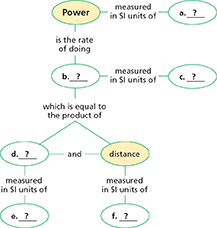CHAPTER 14 Study Guide
14.1 Work and Power
 Key Concepts
Key Concepts
. Work is done on an object when a force acts in the same direction as the object moves.
. Power is the rate of doing work. Doing work faster requires more power.
Vocabulary
14.2 Work and Machines
 Key Concepts
Key Concepts
Machines make work easier by changing the force needed, the direction of the force, or the distance over which the force acts.
Work output (done by a machine) is always less than the work input (done on the machine).
Vocabulary
machine, p. 417
input force, p. 419
input distance, p. 419
work output, p. 419
output force, p. 420
output distance, p. 420
work output, p. 420
14.3 Mechanical Advantage and Efficiency
 Key Concepts
Key Concepts
Friction is present in all machines. Because of friction, the actual mechanical advantage is always less than the ideal mechanical advantage.
Because of friction, the efficiency of any machine is always less than 100 percent.
Vocabulary
mechanical advantage, p. 421
actual mechanical advantage, p. 422
ideal mechanical advantage, p. 423
efficiency, p. 425
14.4 Simple Machines
 Key Concepts
Key Concepts
The six types of simple machines are the lever, the wheel and axle, the inclined plane, the wedge, the screw, and the pulley.
Vocabulary
lever, p. 428
fulcrum, p. 428
input arm, p. 428
output arm, p. 428
wheel and axle, p. 430
inclined plane, p. 431
wedge, p. 431
screw, p. 431
pulley, p. 432
compound machine, p. 435
Thinking Visually
Concept Map Use information from the chapter to complete the concept map below.





